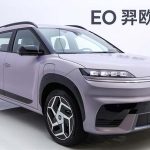 Scientists from Fraunhofer Institute have replaced a battery box for lithium-ion batteries with a lightweight component, that not only save weight and sustain no damage in an accident, but for the first time ever, it can also be mass-produced.
Scientists from Fraunhofer Institute have replaced a battery box for lithium-ion batteries with a lightweight component, that not only save weight and sustain no damage in an accident, but for the first time ever, it can also be mass-produced.
If an electric car wants to be environmentally friendly it must weigh as little as possible, because when the light turns green every additional pound/kilogram must be accelerated with considerable energy expenditure.
And the lighter the electric car, the longer it can be on the road without having to be plugged back into a power outlet. To advance the symbiosis between electromobility and lightweight construction, engineers from the Fraunhofer are developing manufacturing concepts that have one goal – they want to gradually replace individual components in the vehicle with lightweight ones. “However, this cannot affect the stability or the safety of the passenger,“ said Manfred Reif, project manager in the joint project ”Fraunhofer System Research for Electromobility.”
The fact that this is possible is proven by the researchers with the Artega GT, a sports car that was modified into a prototype with an electric drive, where the electric motor is located in the rear. The experts, along with colleagues from the Fraunhofer Institutes for Mechanics of Materials IWM, for Structural Durability and System Reliability LBF and for High-Speed Dynamics, Ernst-Mach Institut EMI, have developed a mass-production-ready, crash-safe battery housing that meets strict requirements.
The battery housing that surrounds the battery that weighs 340 kilograms (749.57 lbs.) only weighs 35 kilograms (77.16 lbs.). “Traditional solutions made of steel weigh up to 25 percent more,“ said Reif. “The battery housing can withstand a crash, assuming a ten-fold gravitational acceleration.“ And even if a sharp object collides with the housing at 60 km/h (45mph), the highly sensitive battery on the inside remains intact. In addition, the 16 lithium-ion modules are protected from humidity, and a semi-permeable membrane to equalize pressure also guarantees that the batteries are able to “breathe.“
What make the new battery protection so special are the new fiber-reinforced composite materials. Currently, steel components are welded together to make these boxes.
“However, it must be possible to mass-produce the lightweight components,“ explained Reif. “Up to now, this has not been possible in this form.“ Fiber composites have been used for a long time in the manufacturing of airplanes; however, only a few hundred are built every year. But as far as cars are concerned, this number could be several thousand daily, and mass production involves completely different requirements as far as materials are concerned. For this reason, the scientists have developed a special process chain with cycle times that make the production of high unit counts possible. “The process chain is designed so that many steps can be run simultaneously,“ said Reif. For example, the plastic is heated up parallel to the production step, and elements are prepared that ensure load and tensile strength or the attachment to the storage in the rear of the Artega. This includes, for example, directionally oriented fiberglass structures or custom-made metal inserts. All the individual components are then assembled and pressed together in a “one-shot process.“
[source: Fraunhofer Institute]




